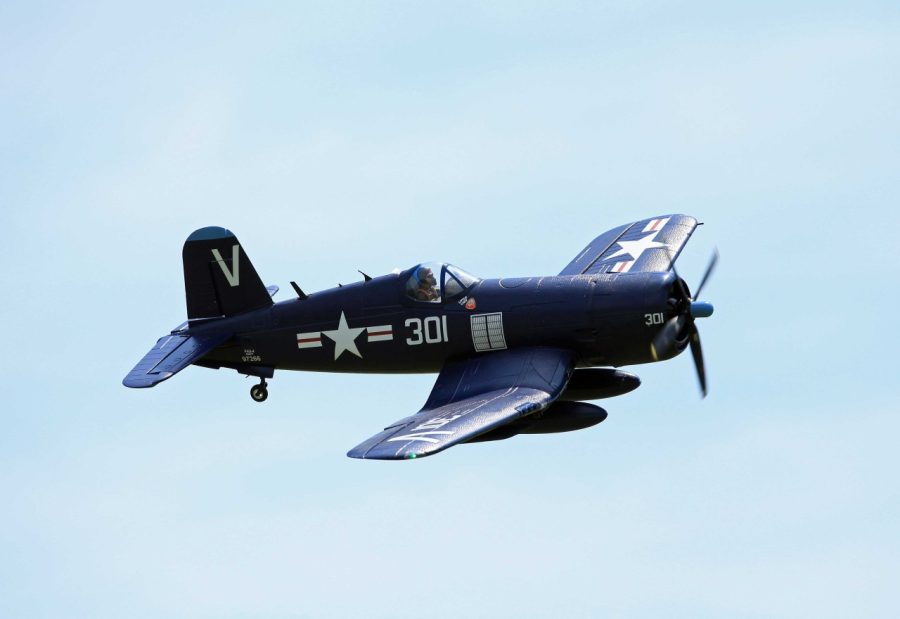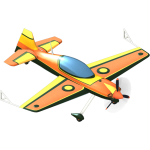For many fans of RC model planes, military aircraft like Mustangs, Corsairs, and Spitfires have a special place in their hearts. Even the Panthers, F-86s, and F-15s are a big hit among them, though we might not immediately think of them as part of this group. These RC planes are typically bigger and heavier, with their wings carrying more weight. This means you need to be extra mindful when flying them. But here’s the cool part: when these military models are made even larger, they often fly even better!
 Having wings that carry more weight isn’t always a downside. In fact, it can make the plane less affected by sudden wind gusts and helps in making landing smoother and more predictable. Once you’ve got your descent rate in check, adjusting the power can easily control it. But there’s a catch: if you try to lift your awesome model plane off the ground too early, before its wings are ready to do their job, you might see it suddenly drop back down. And if you’re thinking quick reflexes can always save the day, think again.
Having wings that carry more weight isn’t always a downside. In fact, it can make the plane less affected by sudden wind gusts and helps in making landing smoother and more predictable. Once you’ve got your descent rate in check, adjusting the power can easily control it. But there’s a catch: if you try to lift your awesome model plane off the ground too early, before its wings are ready to do their job, you might see it suddenly drop back down. And if you’re thinking quick reflexes can always save the day, think again.
Imagine you’re flying straight, then decide to take a sharp left turn. It looks cool, so you push a bit harder and faster. But suddenly, without warning, your plane trembles, tilts, and spirals down. Your only hope is if you’re high enough to recover.
On the flip side, there are the lightweight WW I models like Fokkers and Spads. Their wings don’t carry as much weight, which can make them somewhat easier to handle. But they still need care and the right techniques. For example, if you’re trying to make a sharp turn with just the aileron, it won’t work. You’ll also need to use the rudder, either manually or through a radio mix. This is where combining rudder and aileron controls comes into play. Mastering this will let you pull off impressive landings where the plane seems to slide sideways. These cross-control landings are not only fun but can quickly reduce height. However, remember, as the wing weight increases, this trick becomes less effective.
The Perfect Starter Military Plane
Contents
When you’re moving up from regular-sized RC planes to the big league, it’s crucial to pick your first large-scale military model carefully. We often let our excitement get the better of us, thinking we can handle complex models right away. But, trust me, it’s not time for that dreamy 120-inch B-25 just yet. Steer clear of the urge to dive straight into intricate multi-engine or jet-powered models.
Is there a “one-size-fits-all” first model? Probably not. Your pick usually comes down to which real airplane you’re smitten with. If you’re set on replicating a specific airplane in miniature, understand that it might not be the easiest to fly. But if you’re up for the challenge, go for it! Otherwise, you might end up with an impressive, but grounded, showpiece for your living room. However, if you’re more into flying a scale model without being attached to a particular real-life plane, choosing becomes a breeze.
Given the array of large military ready-to-fly models out there, and more coming, your biggest dilemma might be deciding on the size. Consider the Mustang; it’s out there in countless sizes and styles. There are plenty of other models too, each in multiple sizes. Some are naturally easier to handle than others, but with today’s technology, all can be prepped for flight much faster than assembling from a high-end kit.
In my opinion, if you’re looking for the best starter giant-scale military model, think about planes like the T-34 Mentor or T-28 Trojan. Here’s why: they’re well-balanced, have low wings, broad-set wheels, ample wing space, and just the right amount of tilt. At bigger sizes, they’re weighty enough and have the right wing density to handle a bit of wind, making for smooth landings and easy maneuvering on the ground. On the other hand, World War I models like the SE-5, Fokker, or Nieuport can be a handful when it’s windy. Their tight-set wheels and rear tailskids can turn every takeoff or landing on a paved track into a mini-adventure.
Mastering the Art of Giant-Scale Warbird Flight
Flying one of those huge warbird models isn’t like your everyday RC flying or other smaller model planes. Sure, some skills from regular flying can help, but these big birds have their own set of rules. It’s a bit like learning to ride a bike and then switching to a motorcycle – some things carry over, but they’re still very different. One of the coolest ways I’ve found to get the hang of it? Watch real, full-sized planes in action! It might sound like common sense, but you’d be surprised how many model planes don’t fly anything like their real-world counterparts.
Today, we have so many ways to watch planes – from YouTube videos to TV shows about warplanes and even live airshows. Why not use them to see how your model should really fly? For instance, you’ll notice that most warbirds don’t just shoot straight up from the runway. They have a certain grace and style to them. By watching, you’ll learn fun facts, like how a T-6 doesn’t loop the same way as a sporty Extra 300. The T-6 kind of slows down at the top, almost like it’s taking a breath before finishing the move.
And while your model might be able to do some wild stunts, remember that the real-life versions often didn’t. For example, your model P-51 might pull off some crazy spins, but real ones didn’t usually do those tail slides. You put so much effort into making your model look like the real deal. So, why not go the extra mile and fly it like it’s the real thing?
Flaps Make Flying Cooler!
Getting your first World War II-style RC plane? You might want to add flaps to it. Why? Because they look super cool, especially when you’re about to land. Plus, they change how you bring the plane in for a landing. With flaps, your plane comes in shorter and slower, letting you keep some power on and guide it smoothly onto the runway. This way, it doesn’t just glide past you when there’s no breeze pushing against it.
When you use flaps, your plane slows down quite a bit, and the front might tilt up a tiny bit. Here’s a pro tip: use your remote’s mixing feature. It links the flaps with the elevator (the part that makes your plane go up and down). This way, as the flaps come out, the elevator adjusts, so you don’t have to manage both at once. This keeps the plane’s nose from suddenly pointing up.
I don’t often use flaps when taking off. But if I do, it’s for show. I’ll use a small angle, like 10 to 15 degrees – just enough so people can see it but not so much that it changes how the plane flies. At this angle, the flaps help the wings lift the plane without slowing it down.
For landings, I go for a bigger angle, between 45 to 60 degrees. This creates the drag (or resistance) you want. But remember, every plane and pilot is different. Test different flap angles high up in the sky until you find what works best for you. It’s best to practice about 200 feet off the ground. This gives you room to fix any mistakes.
Here’s a landing tip: start slowing down when you’re flying parallel to where you’re standing. Put the landing gear down, make your turn, and start lowering the flaps. By the time you’re lined up with the runway, your flaps should be all the way out. Decide where you want to land on the runway. Use the plane’s power to manage your descent, then touch down smoothly, aiming for a stylish two-wheel landing. But don’t relax just yet! Your plane is still rolling. After the back wheel touches down and stays down, bring the flaps back in. Pull back slightly on the controls to keep the tail down and drive your plane back to its starting spot. Easy, right?
Hiding the Landing Gear
Remember that smooth landing you pulled off? You lowered the wheels, and they did their job perfectly. For big military-style RC planes, having wheels that can hide away is pretty much the norm. Just think about seeing that P-51 plane flying with thin, awkward-looking legs hanging down. Doesn’t look too cool, right?
These days, the technology for these hideaway wheels is top-notch. Straight out of the package, they look realistic, work without a hitch, and are a breeze to set up. Some companies that make these RC planes even throw them in when you buy the main body of the plane. Now, when it comes to how these wheels work, you’ve got two main choices: air-powered or gear-driven (which includes electric ones). Both have their pros and cons. Want your wheels to move at a realistic speed? No problem! There are special valves that let you adjust that. Some even let you control the order in which the wheel covers move. Picking the right one mostly comes down to what you like, often influenced by what you’ve used before. If you’re new to RC planes with this feature, it’s a good idea to chat with other enthusiasts nearby to see what they recommend.
Where to Take Your Big RC Plane for a Spin
Here’s the deal with super-sized RC planes: they’re not like those small ones you see zipping around in local parks! When picking a spot to fly yours, you need to make sure there’s enough space for its size and the area it’ll fly around in. Double-check if your regular flying spot can handle these big, speedy models. If it can’t, you’ll need to find a place that’s safe for such activities. Got buddies in your club who fly big planes? You’re set! But if you’re flying solo, it’s a good idea to team up with someone who knows their way around these giant planes.
Going it alone can be risky, especially if you’re new to this and aren’t aware of the challenges. Remember, those large blades powered by strong engines can be dangerous if not handled correctly.
Safety First: Precautions While Flying
Navigating the vast skies with your RC warbird can be exhilarating, but it’s essential to prioritize safety every step of the way. Just as real pilots follow protocols to ensure safe flights, RC enthusiasts should also adhere to specific precautions. Here’s a handy guide to keep you and your warbird safe:
Choose Your Flying Space Wisely:
Opt for open spaces away from crowds, like fields or designated RC flying areas. This reduces the risk of accidents and ensures you have a clear line of sight to your aircraft.
Be wary of areas with tall obstacles like trees, buildings, or power lines. They can be tricky to navigate around, especially for beginners.
Weather Watch:
Always check the weather forecast before heading out. Strong winds can make flying challenging, even for experienced pilots. Rain, fog, or snow can damage your warbird and reduce visibility.
Remember, the larger and heavier warbirds might handle better in mild wind gusts, but they’re not immune to the forces of nature.
Frequent Equipment Checks:
Before every flight, inspect your warbird for any visible damages, loose parts, or malfunctioning components. A quick check can prevent in-flight failures.
Ensure your batteries are fully charged and in good condition. A sudden loss of power in mid-air can lead to unfortunate accidents.
Know Your Warbird:
Familiarize yourself with the controls and capabilities of your RC plane. Spend time practicing on simulators or with smaller models before venturing out with a giant-scale warbird.
Always be aware of your plane’s range to avoid losing control if it goes too far.
Stay Informed:
If you’re flying in a designated area, be sure to know the rules and guidelines. Some places might have specific flight ceilings or no-fly zones.
Join local RC clubs or online forums. Engaging with experienced flyers can provide invaluable safety tips and insights.
Emergency Preparedness:
Always have a plan in case things go south. Whether it’s a sudden descent or a lost signal, knowing what to do can prevent further damage.
Keep a first aid kit handy. While these models might seem harmless, they can cause injuries, especially when moving at high speeds.
Remember, flying an RC warbird is a thrilling hobby, but it’s paramount to balance that thrill with safety. Adhering to these precautions will ensure you have countless enjoyable flights without compromising the well-being of yourself, others, or your cherished warbird. Safe flying!
Maintenance and Upkeep: Ensuring the Longevity of Your RC Warbird
Diving into the world of RC Warbirds is exhilarating, but like any prized possession, they require tender loving care. Proper maintenance and timely upkeep are essential to keep these airborne wonders in top-notch condition. Whether you’re a newbie or a seasoned flyer, these tips will help ensure your military model plane always takes to the skies with gusto.
Regular Inspections:
Before and after every flight, make it a ritual to inspect your aircraft. Look for any signs of wear and tear, especially on the wings, propeller, and landing gear. Small issues can quickly become big problems if left unattended.
Battery Care:
The heart of your RC Warbird is its battery. Ensure it’s fully charged before flying and avoid over-discharging. After use, store batteries in a cool, dry place, away from direct sunlight. Remember, a well-maintained battery not only extends flight time but also the lifespan of your aircraft.
Cleanliness is Key:
After each flight, give your plane a gentle wipe-down to remove any dirt, grass, or debris. For those intricate parts, a soft brush or compressed air canister can work wonders. This not only keeps your Warbird looking sharp but also prevents potential mechanical issues.
Propeller and Motor Maintenance:
Ensure the propeller is free from nicks and is balanced. An unbalanced propeller can cause unwanted vibrations, affecting flight performance. Regularly check the motor for any signs of overheating or wear.
Lubrication:
Just like real aircraft, your model requires regular lubrication. Focus on the moving parts such as hinges and servos. Use a light RC-specific oil, avoiding household oils which can attract dirt.
Store Smartly:
When not in use, store your RC Warbird in a cool, dry place. If you’re storing it for an extended period, remove the battery and keep the aircraft off the ground to prevent flat spots on the tires.
Stay Updated:
Technological advancements are continuous. Keep an ear to the ground for any updates or modifications that can enhance your Warbird’s performance. Joining RC forums or local clubs can be a great way to stay in the loop.
Seek Expert Help:
If you come across an issue that’s beyond your expertise, don’t hesitate to consult with veteran flyers or professionals. Sometimes, a little expert advice can save you a lot of time and money in the long run.
In essence, the longevity and performance of your RC Warbird largely depend on the care you provide. With regular maintenance and a keen eye for detail, you can ensure countless hours of thrilling flights and aerial adventures.
Where the Fun Begins
Visiting popular RC events like can teach you loads just by watching and chatting. Local flying get-togethers are on the rise too, and they’re super relaxed since there’s no pressure of a contest. It’s pretty likely you’ll bump into someone building the same model plane you are. They’ll probably be more than happy to share tips and tricks they’ve picked up. Plus, you’ll quickly notice the enthusiasts who’ve really paid attention to how real military planes fly. Their miniatures won’t just look authentic – they’ll feel real up in the sky too.
Taking on the task of mastering a large-scale military plane is quite the thrill. Once you get the hang of it, you’ll definitely have some bragging rights among your pals. Just imagine the buzz when you roll out with your massive model plane. Now, fly that thing like a pro, and you’ll steal the show! It requires some serious skills and a whole lot of practice to get it just right. But hey, you set your own goals, so revel in every moment of it! Some folks feel like they missed out on the golden age of aviation. But with these scale RC models, especially the ones from World War II, they might just find the excitement they’ve been looking for.




